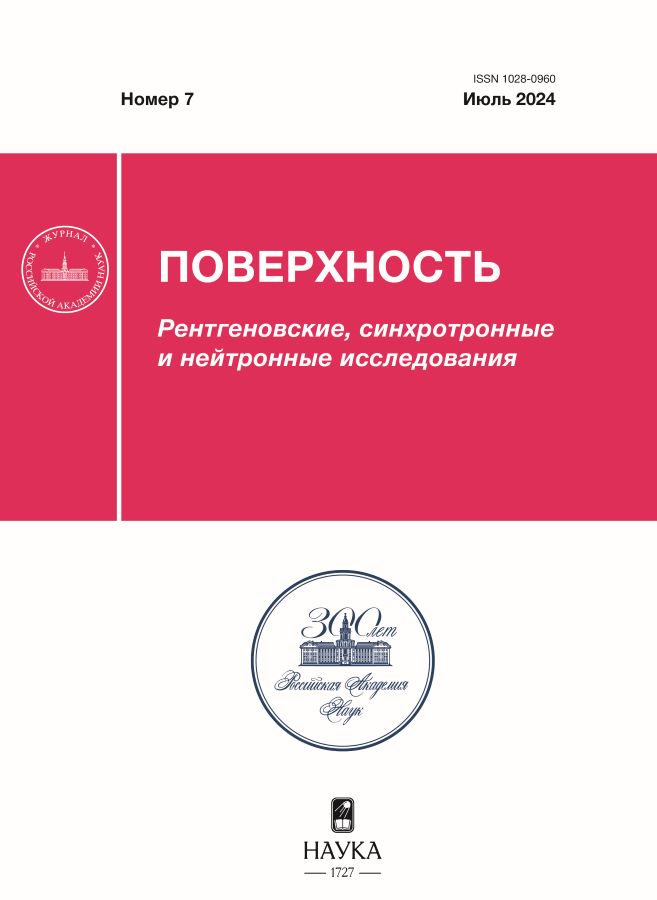Ion implantation: nanoporous germanium
- 作者: Stepanov A.L.1, Nuzhdin V.I.1, Valeev V.F.1, Rogov А.М.1, Konovalov D.А.1
-
隶属关系:
- Zavoisky Physical-Technical Institute, FRC Kazan Scientific Center of the RAS
- 期: 编号 7 (2024)
- 页面: 83-90
- 栏目: Articles
- URL: https://kld-journal.fedlab.ru/1028-0960/article/view/664797
- DOI: https://doi.org/10.31857/S1028096024070119
- EDN: https://elibrary.ru/EUSZJE
- ID: 664797
如何引用文章
详细
The formation of thin surface amorphous layers of nanoporous Ge with various morphology during low-energy high-dose implantation by metal ions of different masses 63Cu+, 108Ag+ and 209Bi+ of monocrystalline c-Ge substrates were experimentally demonstrated by high-resolution scanning electron microscopy. Analysis of the crystallographic structure of all nanoporous germanium layers obtained was carried out by reflected backscattering electron diffraction. It was shown that at low irradiation energies, in the case of 63Cu+ and 108Ag+, needle-shaped nanoformations were created on the c-Ge surface, constituting a nanoporous Ge layer, while when using 209Bi+, the implanted layer consists of densely packed nanowires. At high energies, the morphology of thin surface layers of nanoporous germanium changes with an increase in the mass of the implanted ions from three-dimensional network to spongy with separate discharged interlacing nanowires. General possible mechanisms of pore formation in Ge during low-energy high-dose ion implantation, such as cluster-vacancy, local thermal microexplosion, and point heating accompanied by melting, are discussed.
全文:
作者简介
A. Stepanov
Zavoisky Physical-Technical Institute, FRC Kazan Scientific Center of the RAS
编辑信件的主要联系方式.
Email: aanstep@gmail.com
俄罗斯联邦, Kazan
V. Nuzhdin
Zavoisky Physical-Technical Institute, FRC Kazan Scientific Center of the RAS
Email: aanstep@gmail.com
俄罗斯联邦, Kazan
V. Valeev
Zavoisky Physical-Technical Institute, FRC Kazan Scientific Center of the RAS
Email: aanstep@gmail.com
俄罗斯联邦, Kazan
А. Rogov
Zavoisky Physical-Technical Institute, FRC Kazan Scientific Center of the RAS
Email: aanstep@gmail.com
俄罗斯联邦, Kazan
D. Konovalov
Zavoisky Physical-Technical Institute, FRC Kazan Scientific Center of the RAS
Email: aanstep@gmail.com
俄罗斯联邦, Kazan
参考
- Степанов А.Л., Нуждин В.И., Рогов А.М., Воробьев В.В. Формирование слоев пористого кремния и германия с металлическими наночастциами. Казань: ФИЦПРЕСС, 2019. 198 c.
- Rojas E.G., Hensen J., Carstensen J., Föll H., Brendel R. // RCS Transactions. 2011. V. 33. P. 95. https://www.doi.org/10.1149/1.3553351
- Nowak D., Turkiewicz M., Solnica N. // Coatings. 2019. V. 9. P. 120. https://www.doi.org/10.3390/coatings9020120
- Zhang Y.-Y., Shin S.-H., Kang H.-J., Jeon S., Hwang S.H., Zhou W., Jeong J.-H., Li X., Kim M. // Appl. Surf. Sci. 2021. V. 546. P. 149083. https://www.doi.org/10.1016/j.apsusc.2021.149083
- Степанов А.Л., Нуждин В.И., Валеев В.Ф., Коновалов Д.А., Рогов А.М. // Письма ЖТФ. 2023. Т. 49. № 8. С. 10. https://www.doi.org/10.21883/PJTF.2023.08.55129.19446
- Uchida G., Nagai K., Habu Y., Hayashi J., Ikebe Y., Hiramatsu M., Narishige R., Itagaki N., Shiratani M., Setsuhara Y. // Sci. Rep. 2022. V. 12. P. 1742. https://www.doi.org/10.1038/s41598-022-05579-z
- Гаврилова Т.П., Хантимеров С.М., Нуждин В.И., Валеев В.Ф., Рогов А.М., Степанов А.Л. // Письма ЖТФ. 2022. Т. 48. № 8. С. 33. https://www.doi.org/10.21883/PJTF.2022.08.52364.19096
- Evtugin V.G., Rogov A.M., Nuzhdin V.I., Valeev V.F., Kavetsky T.S., Khalilov R.I., Stepanov A.L. // Vacuum. 2019. V. 165. P. 320. https://www.doi.org/10.1016/j.vacuum.2019.04.044
- Koleva M.E., Dutta M., Fukata N. // Mater. Sci. Engineer. B. 2014. V. 187. P. 102. https://www.doi.org/10.1016/j.mseb.2014.05.008
- Zegadi R., Lorrain N., Bodiou L., Guendouz M., Ziet L., Charrier J. // J. Opt. 2021. V. 23. P. 35102. https://www.doi.org/10.1088/2040-8986-abdf69
- Donovan T.M., Heinemann K. // Phys. Rev. Lett. 1971. V. 27. № 26. P. 1794.
- Flamand G., Pooetmans J., Dessein K. // Phys. Stat. Sol. C. 2005. V. 2. № 9. P. 3243. https://www.doi.org/10.1002/pssc.200461130
- Shieh J., Chen H.L., Ko T.S., Cheng H.C., Chu T.C. // AdV. Mater. 2004. V. 16. № 13. P. 1121. https://www.doi.org/10.1002/adma.200306541
- Kartopu G., Bayliss S.C., Hummel R.E., Ekinci Y. // J. Appl. Phys. 2004. V. 95. № 7. P. 3466. https://www.doi.org/10.1063/1.650919
- Foti G., Vitali G., Davies J.A. // Rad. Effects. 1977. V. 32. P. 187.
- Wilson I.H. // J. Appl. Phys. 1982. V. 53. № 3. P. 1698.
- Rudawski N.G., Jones K.S. // J. Mater. Res. 2013. V. 28. № 13. P. 1633. https://www.doi.org/10.1151/jmr.2013.24
- Stepanov A.L., Nuzhdin V.I., Valeev V.F., Rogov A.M., Vorobev V.V. // Vacuum. 2018. V. 152. P. 200. https://www.doi.org/10.1016/j.vacuum.2018.03.030
- Рогов А.М., Нуждин В.И., Валеев В.Ф., Романов И.А., Климович И.М., Степанов А.Л. // Российские нанотехнологии. 2018. Т. 13. № 9–10. С. 35.
- Rogov A.M., Nuzhdin V.I., Valeev V.F., Stepanov A.L. // Composites Commun. 2020. V. 19. P. 6. https://www.doi.org/10.1016/j.coco.2020.01.002
- А.П. Александров Документы и воспоминания. К 100-летию со дня рождения. / Ред. Хлопкин Н.С. М.: ИздАТ, 2003. 456 с.
- Ziegler J.F., Ziegler M.D., Biersack J.P. // Nucl. Instr. Meeth. Phys. Res. B. 2010. V. 268. P. 1818. https://www.doi.org/10.1016/j.nimb.2010.02.091
- Nastasi M., Mayer J.W., Hirvonen J.K. Ion-solid interactions. Cambridge: Cambridge UniV. Press, 1996. 540 p.
- Darby B.L., Yates B.R., Rudawski N.G., Jones K.S., Elliman R.G. // Thin Solid Films. 2011. V. 519. P. 5962. https://www.doi.org/10.1016/j.tsf.2011.03.040
- Cawthorne C., Fulton E.J. // Nature. 1967. V. 216. № 11. P. 576.
- Romano L., Impellizzeri G., Tomasello M.V., Giannazzo F., Spinella C., Grimaldi M.G. // J. Appl. Phys. 2010. V. 107. P. 84314.
- Ghaly M., Nordlund K., Averback R.S. // Philosoph. Magazin. 1999. V. 79. № 4. P. 795.
- Герасименко Н.Н., Пархоменко Ю.Н. Кремний — материал наноэлектроники. М.: Техносфера, 2007. 352 с.
- Kudriavtsev Y., Hernandez-Zanabria A., Salinas C., Asomoza R. // Vacuum. 2020. V. 177. P. 109393. https://www.doi.org/10.1016/j.vacuum.2020.109393
- Kudriavtsev Y., Asomoza R., Hernandez A., Kazantsev D.Y., Ber B.Y., Gorokhov A.N. // J. Vac. Sci. Technol. A. 2020. V. 38. № 5. P. 53203. https://www.doi.org/10.1116/6.0000262
补充文件
















